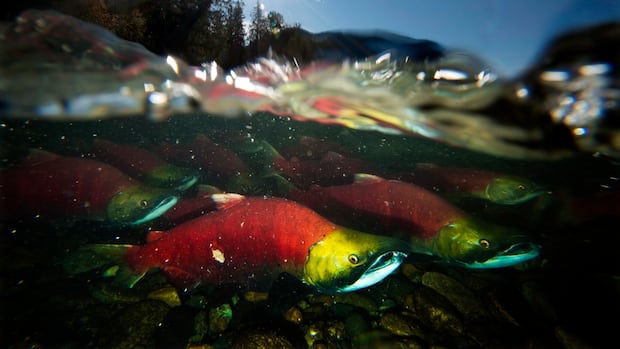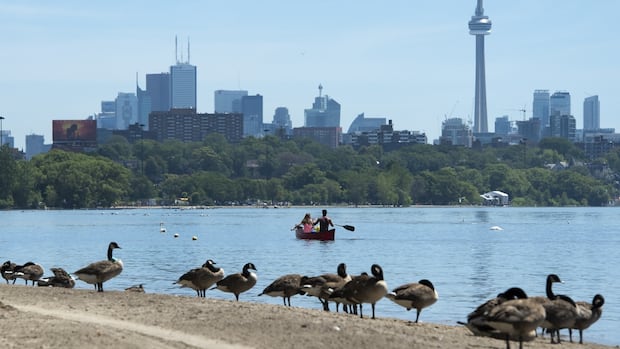The snowy owl, Quebec’s majestic avian emblem and Harry Potter’s iconic companion, is at risk of becoming endangered if action isn’t taken to reverse the threats to its survival, an independent advisory panel has concluded.
This week, the Committee on the Status of Endangered Wildlife in Canada (COSEWIC) classified the species as threatened in the country.
While the expert group has made this designation, the governments of Canada and Quebec have yet to officially recognize this status.
The Ecomuseum Zoo in Sainte-Anne-de-Bellevue, Que., sounded the alarm this week, calling on the provincial government to act swiftly.
“Alarm bells should be ringing in Quebec,” wrote the zoo in a statement sent to CBC.
David Rodrigue, the zoo’s executive director, pointed to a range of factors behind the snowy owl’s decline — many of them human-caused.
“We should all take it as a wake-up call and really start looking at what it really means to try and change the current trends in global warming,” he said.
Snowy owls rely heavily on lemmings as a food source — a small rodent species also in decline, said Rodrigue.
Lemmings survive the winter by digging tunnels through the snow to feed on grasses and mosses. But with more rain events in the winter, the snow cover in the Arctic becomes more icy and solid, making it difficult for lemmings to dig.
This leads to malnourishment, population crashes and ultimately, impacts on snowy owl populations, whose numbers aren’t recovering naturally due to the persistence of these environmental pressures, added Rodrigue.
And the owl doesn’t just face problems up north.
Rodrigue noted that many of them migrate south in winter — reaching areas like Montreal and the South Shore — where they often die after eating rodents that have been poisoned by rodenticides used in agriculture.
“What’s happening now is we’re pulling out, so to speak, species one by one. And there is a point where ecosystems don’t function anymore without a certain number of species in there,” said Rodrigue, comparing the ecosystem to a game of Jenga.
“You can pull [pieces] out for a long time and [the tower] stands. But at one point, you pull one out, everything collapses. That’s how we’re linked.”
Over 40% decline in population
COSEWIC is an independent advisory body to Canada’s Environment and Climate Change Ministry (ECCC). It includes wildlife biology experts from government organizations, non-governmental groups, academia and the private sector.
Louise Blight, co-chair of COSEWIC’s bird specialist sub-committee, said the designation was based on a population decline over three generations — which corresponds to around 24 years.
“Over that period of time, the snowy owl has been seen to decline by over 40 per cent. That means it meets the criteria for threatened,” she said.
“Canadians and non-Canadians should be concerned about the status of snowy owls.”
The committee has recommended that the federal government add the bird to Canada’s list of threatened species. Blight identified several other threats contributing to the decline, including sea ice loss, electrocution and avian influenza.
To address the crisis, Blight suggests more responsible approaches to rodent control, environmentally friendly agricultural practices, avian flu mitigation efforts and action on climate change.
In a statement, the ECCC stated that the committee is expected to submit its assessment in the fall of 2025.
“Following this step, the minister must post a response statement to the Species at Risk Public Registry within 90 days. This initiates a consultation process,” read the statement.
Hit by cars, caught in power lines
Guy Fitzgerald, a clinician at the Université de Montréal’s birds of prey clinic who participated in the committee’s discussions, said snowy owls are not used to human threats.
“We see lots of snowy owls hit by cars, they can hit power lines,” he said, adding they hunt near roads and airports because small rodents are easier to catch where there’s no vegetation.
One snowy owl was brought to his clinic after being rescued by a bird watcher. It had been tangled in a barbed wire fence, and one of its wings was severely injured.
“Its whole wing was amputated. It’s a bird that will end its days in a refuge or a zoological institution,” Fitzgerald said.
He noted that the clinic’s goal is to release birds of prey back into the wild. In this case, it wasn’t possible.
The Committee on the Status of Endangered Wildlife in Canada says the snowy owl population has gone down by more than 40 per cent in 24 years.
He explained that snowy owls often don’t see fences when flying low to hunt and that they’re among the species that have been hit by gunshots over the past three decades, emphasizing the need for greater public education.
“We have to take care of them, but we have to consider them as an ecological service,” he said, highlighting that snowy owls can help regulate other animal populations.
“More and more, we understand that the fragile equilibrium is dependent on the biodiversity.”
Not enough data collected in Quebec
According to Rodrigue, there isn’t enough data being collected on the snowy owl in Quebec and the national decline in the species likely reflects a similar trend within the province.
“It’s fairly obvious, scientifically speaking, that it’s already happening here,” he said. Still, he noted that the snowy owl isn’t even labelled as a species that is susceptible of being threatened or endangered in the province.

Following the committee’s classification, Quebec’s Environment Ministry told CBC it will evaluate the status of the species based on available data.
Rodrigue sees this designation as a perfect opportunity for the provincial government to move forward, and faster.
“That big rock that we live on … we’re basically borrowing it from our children and we’re going to have to give it back at some point,” he said.
“We might as well make sure that we give it back in working condition.”








